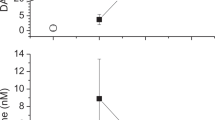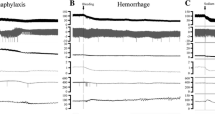Summary
A prospective controlled clinical trial was conducted on changes in plasma histamine and catecholamine levels during 5 standard operations. This communication, as the first part of the trial, deals only with the feasibility of such a trial and the changes in plasma histamine levels.
Elevated histamine concentrations corresponding to histamine-release responses of >1 ng/ml occurred in 8 of 25 operations. In an explorative analysis these reponses were associated with distinct phases of anaesthesia or the surgical procedure.
Blood transfusion carried the risk of infusion of “free histamine” into the patient — especially when administered under pressure.
Since during operations “free histamine” enters the circulation with a rather high incidence and may cause harmful effects, premedication with H1-+H2-receptor antagonists seems worth consideration.
Zusammenfassung
Eine prospektive kontrollierte klinische Studie wurde über Veränderungen des Plasmahistamin- und Katecholaminspiegels bei 5 Standardoperationen durchgeführt. Diese Mitteilung, als erster Teil der Studie, zeigt nur die Möglichkeiten auf, eine solche Studie durchzuführen und Veränderungen des Plasmahistaminspiegels nachzuweisen.
Erhöhte Plasmahistaminkonzentrationen, die einer Histaminfreisetzungsreaktion von >1 ng/ml entsprechen, kamen bei 8 von 25 Operationen vor. In einer explorativen statistischen Analyse wurden diese Reaktionen mit bestimmten Phasen der Anästhesie oder des chirurgischen Eingriffs in Verbindung gebracht.
Bluttransfusionen tragen das Risiko in sich, „freies Histamin“ in den Patienten zu infundieren — zumal bei Filterpassage, wenn es unter erhöhtem Druck angewandt wird. Da während Operationen recht häufig „freies Histamin“ in die Zirkulation gelangt und möglicherweise schädigende Wirkungen entfaltet, ist möglicherweise eine Prämedikation mit H1- und H2-Rezeptorantagonisten ratsam.
Similar content being viewed by others
References
Altura BM, Halevy S (1978) Circulatory shock, histamine and antihistamines: therapeutic aspects. Handbook exper Pharmacol Vol 18/2. Springer, Berlin Heidelberg New York, pp 575–602
Beaven MA, Jacobsen S, Horáková Z (1972) Modification of the enzymatic isotopic assay of histamine and its application to measurement of histamine in tissues, serum and urine. Clin Chem Acta 37:91–103
Begent NA, Born GVR and Scharp DE (1972) The initiation of platelet thrombi in normal venules and its acceleration by histamine. J Physiol (London) 223:229–242
Beger HG, Stopik D, Bittner R, Kraas E, Rescher R (1975) Der Einfluß der Leber auf die Plasmahistaminkonzentrationen. Messungen im prä- und posthepatischen Blut vor und nach abdominellen Operationen. Z Gastorenterol 13:474–478
Berg S, Ditt J, Junze P, Garbe G (1971) Beziehungen zwischen Histamingehalt und Aktivität der Histidindecarboxylase im Bereich von Hautverletzungen. Z Rechtsmedizin 69:26–40
Billings FT, Maegraith BG (1937) Chemical changes in tissues following obstruction of the blood supply. Am J Physiol 27:249–267
Blaschko H, Muscholl E (1972) Catecholamines. Handbook exper Pharmacol. Springer, Berlin Heidelberg New York, pp 1–1011
Dragstedt CA, Measd FB (1937) A pharmacologic study of the toxemia theory of surgical shock. JAMA 108:95–96
Erspamer V (1966) Participation of 5-hydroxytryptamine in physiopathological processes. Handbook exper Pharmacol. Springer, Berlin, Heidelberg, New York, pp 360–423
Feldberg W, Loeser AA (1954) Histamine content of human skin in different clinical disorders. J Physiol (London) 126:286–292
Fischer M, Lorenz W, Reimann H-J, Troidl H, Rohde H, Schwarz B, Hamelmann H (1978) Cimetidine prophylaxis of acute gastroduodenal lesions in patients at risk. In: Creutzfeldt W (ed) Cimetidine. Excerpta Medica, Amsterdam pp 280–290
Koslowski L, Marggraf W, Scheele W (1952) Histaminämie nach Muskeltraumen (Crush-Syndrom). Klin. Wochenschrift 30:365–365
Kusche J, Lorenz W, Stahlknecht C-D, Richter H, Hesterberg R, Schmal A, Hinterlang E, Weber D, Ohmann Ch (1981) Intestinal diamine oxidase and histamine release in rabbit mesenteric ischemia. Gastroenterology 80:980–987
Laurence DR, Bennett PN (1980) Clinical pharmacology, Churchill Livingstone, Edinburgh, London, pp 1–954
Levi R, Allan G (1980) Histamine-mediated cardiac effects. In: Bristow M (ed), Drug-induced heart disease. Elsevier-North Holland Biomedical Press, Amsterdam, pp 377–395
Lewis T, Grant RT (1924) Vascular reactions of the skin to injury (Part II) Heart 11:209–265
Lindenschmidt Th-O, Beger HG, Lorenz W (1981) Kontrollierte klinische Studien: Ja oder Nein? Aufgaben und Grenzen kontrollierter klinischer Studien aus der Sicht des Chirurgen. Chirurg 52:281–288
Lorenz W, Reimann H-J, Barth H, Kusche J, Meyer R, Doenicke A, Hutzel M (1972) A sensitive and specific method for the determination of histamine in human whole blood and plasma. Hoppe-Seyler's Z Physiol Chem 353:911–920
Lorenz W, Hell E, Boeckl O, Reimann H-J, Zimmermann G, Seidel W, Laszcz M, Uhlig R (1973a) Histamine release during orthotopic homologous liver transplantation in pigs. Eur Surg Res 5:11–20
Lorenz W, Seidel W, Doenicke A, Tauber R, Reimann H-J, Uhlig R, Mann G, Dormann P, Schmal A, Häfner G, Hamelmann H (1974) Elevated plasma histamine concentrations in surgery: causes and clinical significance. Klin Wochenschrift 52:419–425
Lorenz W, Doenicke A (1978) Anaphylactoid reactions and histamine release by intravenous drugs used in surgery and anaesthesia. In: Watkins J, Ward AM (eds) Adverse response to intravenous drugs. Academic Press, London; Grune & Stratton New York, pp 83–112
Lorenz W, Doenicke A, Schöning B, Neugebauer E (1981) The role of histamine in adverse reactions to intravenous agents. In: Thornton A (ed) Adverse reactions of anaesthetic drugs. Elsevier/North-Holland Biomedical Press, pp 169–238
Lorenz W, Doenicke A, Schöning B, Ohmann Ch, Grote B, Neugebauer E (1982) Definition and classification of the histamine-release response to drugs in anaesthesia and surgery: Studies in the conscious human subject. Klin Wochenschrift, this issue
MacDonald AD, Woolfe G (1938) Blood histamine in traumatic shock. J Physiol (London) 93:58–59
Markley K, Horáková Z, Smallman ET, Beaven MA (1975) The role of histamine in burn, torniquet and endotoxin shock in mice. Eur J Pharmacol 33:255–265
Minard D (1937) Histamine-like substances in blood following trauma. Am J Physiol 119:375–376
Rocha e Silva M, Rothschild HA (1966) Histamine and antihistamines, Vol 18/1. Springer, Heidelberg, pp 1–991.
Rose B, Browne JSL (1940) Alterations in the blood histamine in shock. Proc Soc Exp Biol Med 44:182–188
Rosenthal SR, Minard D (1939) Experiments on histamine as the chemical mediator for cutaneous pain. J exp Med 70:415–425
Rosenthal SM (1969) Effects of serotonin, adrenaline, noradrenaline and histamine on traumatic swelling. Am J Physiol 216:634–637
Schayer RW (1961) Significance of induced synthesis of histamine in physiology and pathology. Chemotherapia 3:128–136
Schneider H (1930) Über das Vorkommen und über die Bedeutung von Gewebsgiften bei Schockzuständen des Menschen. Arch klin Chir 162:561–563
Schöning B, Lorenz W, Doenicke A (1982) Prophylaxis of anaphylactoid reactions to a polypeptidal plasma substitute by H1-plus H2-receptor antagonists: Synopsis of three randomized controlled trials. Klin Wochenschrift 60:1048–1055
Spuzic TV, Halpern BN (1959) Role de l'histamine dans le choc traumatique. Compt rend scanc Soc Biol 253:1108–1110
Thermann M, Largiader F, Lorenz W, Jostarndt L, Neugebauer E (1978) Plasmahistaminspiegel während und nach Nierenallotransplantionen beim Menschen. Langenbecks Arch Chir [Suppl] 1978:303–306
Vane JR, Ferreira SH (1978) Inflammation, Handbook exp Pharmacol. Springer, Berlin Heidelberg New York, pp 1–784.
Author information
Authors and Affiliations
Additional information
Supported by grant of Deutsche Forschungsgemeinschaft (Lo 199/13-6)
Supported by the Wellcome Trust, London
Rights and permissions
About this article
Cite this article
Röher, H.D., Lorenz, W., Lennartz, H. et al. Plasma histamine levels in patients in the course of several standard operations: Influence of anaesthesia, surgical trauma and blood transfusion. Klin Wochenschr 60, 926–934 (1982). https://doi.org/10.1007/BF01716949
Issue Date:
DOI: https://doi.org/10.1007/BF01716949




